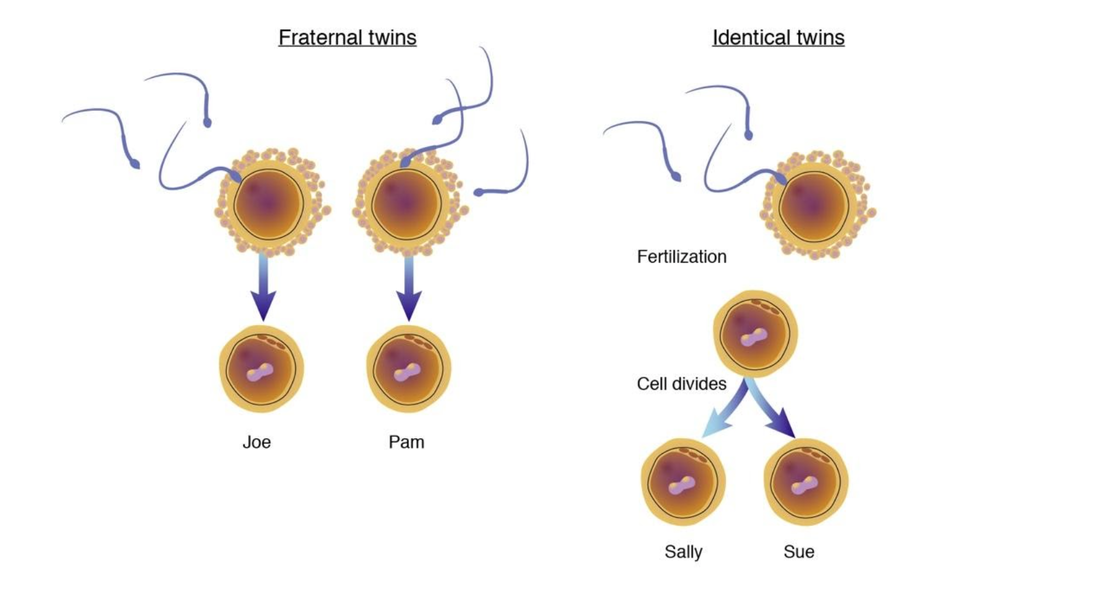|
By: Freda Li  Pregnancy will be a familiar process to most readers of this newspaper: sperm from the father meets an ovum from the mother to form a zygote, which begins dividing within 24 h of formation to start a pregnancy. But 1 in every 250 births, the zygote splits into two. This begins the development of monozygotic twins, or identical twins. Given the fact that these children develop from the same fertilized egg, they will share the same genetic material. It is important to distinguish between fraternal (dizygotic) and identical twins. Fraternal twins are the result of separate eggs being fertilized by separate sperm: they share 50% of their genome, just like any other pair of siblings. Identical twins are the result of one fertilized egg splitting into two organisms: they share ~100% of their genome. This special event makes these children uniquely remarkable to science, as any changes in their biologies and behaviours would result from different environmental influences. Recent studies have found that identical twin DNA differs by 5.2 mutations, derived from errors in DNA replication. However, identical twins are the closest model we have to control human genetic variability, and therefore examine how different environmental factors affect human life. The debate between heredity vs. environment – more colloquially known as “nature vs nurture” – has been a longstanding point of contention. The “middle ground” between these polar concepts is known as epigenetics, the study of how behaviours and environment can alter one’s genetic makeup. Epigenetic changes occur across one’s lifespan and affect health in diverse ways. For example, malnourished mothers during the Dutch Hunger Winter Famine in 1944-45 gave birth to children who were found to have increased likelihood for certain diseases in later life were determined in a study 60 years after the famine. This special identity has enormous value in scientific studies; but it is important to remember that these twins are individuals before they are human experiments. They are entitled to live their lives freely, even if their decisions are inconvenient to interested researchers. There have been instances where twins’ humanity has been egregiously ignored. The 2017 film “The Twinning Reaction” follows psychiatrists Dr. Peter Neubauer and Dr. Viola Bernard, who worked with Louise Wise Adoption Services in the 1960s-70s to separate twins into different adoptive families. These twins did not consent, and families were never informed that their children were separated twins. Researchers visited the children under the pretense of checking their health and integration into the new home when they were actually conducting tests for their research. Many of Neubauer’s subjects experienced mental health issues in later life, and many have encountered issues accessing their own records, which were arranged by Neubauer to be sealed at Yale University until 2065. With ethical guidelines in place, twin studies have been the foundation for some fascinating discoveries. Dr. Thomas Bouchard’s 1979 twin study at the Minnesota Center for Twin and Family research followed James Arthur Springer and James Edward Lewis, identical twins who were adopted by different families and reunited 39 years later. Growing up, Lewis had a dog named Toy. In school, he enjoyed math and carpentry but was never gifted at spelling. Later in life, he married a woman named Linda, divorced Linda, and then married a woman named Betty. He had a son named James Alan. He worked as a security guard, drove a Chevrolet, and smoked avidly. Upon reuniting with James Springer, both James discovered that they had lived the same lives: that, despite separation from Lewis at birth, Springer also had a dog named Toy, enjoyed math and carpentry but never spelling, married a Linda, divorced a Linda, married a Betty, had a son named James Alan, worked as a security guard, drove a Chevrolet, and smoked avidly. They lived within 45 miles of each other, which could explain some of the similarities. Perhaps this is an isolated instance of extraordinary similarity. Still, this story seems like a remarkable example of genetic determinism.
Other twin studies have been significant in clarifying the roles of genetics in obesity, sexual orientation, eating disorders, I.Q., and common diseases such as osteoarthritis and cataracts. Although epigenetics is still a developing field with more questions than answers, current findings seem to point to the interdependency between nature and nurture. Although we have free will, we are inextricably influenced by our genome and our environments. To this day, twin studies reveal exciting new knowledge on epigenetics: for example, NASA’s ground-breaking study with twin astronauts Scott and Mark Kelly reveals enormous insight into epigenetic changes in the extreme space environment. I am appreciative of the ethical contributions of researchers and participants, and excited to observe what is yet to come in the field of epigenetics. References CBC/Radio Canada. (0AD). The Twinning Reaction. CBCnews. https://www.cbc.ca/passionateeye/episodes/the-twinning-reaction. Centers for Disease Control and Prevention. (2020, August 3). What is Epigenetics? Centers for Disease Control and Prevention. https://www.cdc.gov/genomics/disease/epigenetics.htm. Chen, E. (1979, December 9). TWINS REARED APART: A LIVING LAB. The New York Times. https://www.nytimes.com/1979/12/09/archives/twins-reared-apart-a-living-lab.html. Identical Twins Are Not Identical. Office for Science and Society. (2021, January 24). https://www.mcgill.ca/oss/article/general-science/identical-twins-are-not-identical. Krasnewich, D. (0AD). Identical Twins. National Human Genome Research Institute. https://www.genome.gov/genetics-glossary/identical-twins. McCormack, W., & William McCormack 2:49 am, O. 01. (0AD). Records from controversial twin study sealed at Yale until 2065. Yale Daily News Records from controversial twin study sealed at Yale until 2065 Comments. https://yaledailynews.com/blog/2018/10/01/records-from-controversial-twin-study-sealed-at-yale-until-2065/. Perez, J. (2018, September 28). NASA's Twins Study Results Published in Science Journal. NASA. https://www.nasa.gov/feature/nasa-s-twins-study-results-published-in-science. Than, K. (2016, March 4). A Brief History of Twin Studies. Smithsonian.com. https://www.smithsonianmag.com/science-nature/brief-history-twin-studies-180958281/.
0 Comments
Your comment will be posted after it is approved.
Leave a Reply. |
Categories |


 RSS Feed
RSS Feed